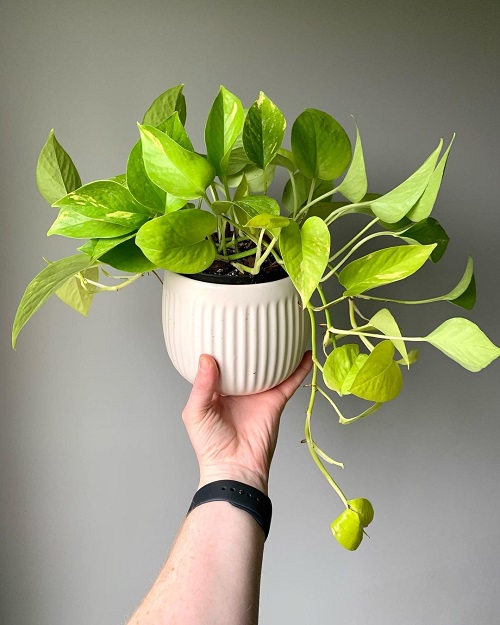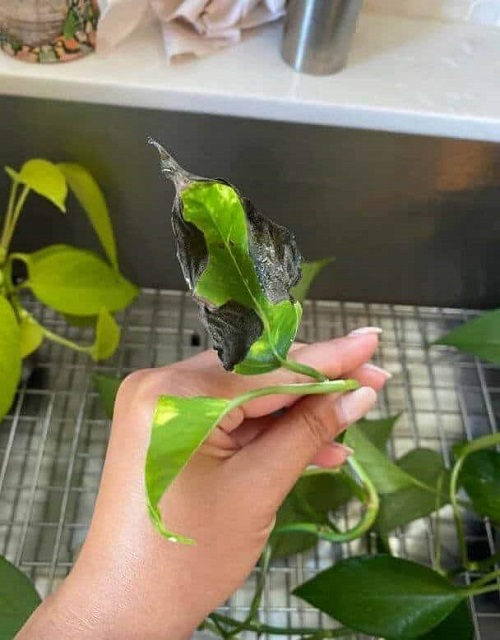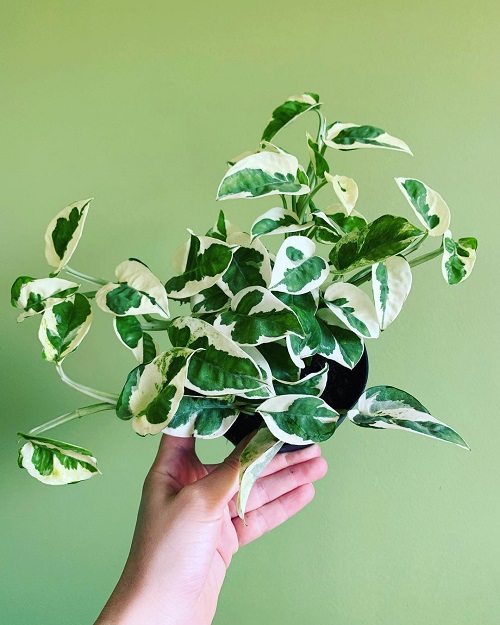Find yourself grappling with Epipremnum aureum issues? Here are the Most Common Pothos Plant Problems you need to be aware of!
Pothos plants are known for their hardy nature and adaptability, making them a favorite among both novice and experienced gardeners. However, like any plant, they can encounter some problems that may jeopardize its health. In this article, we’ll discuss the Most Common Pothos Plant Problems and Their Solutions. We’ll also touch on some less common issues to be aware of.
Have a look at the best types of pothos here
Most Common Pothos Plant Problems and Their Solutions
1. Overwatering

Problem:
Overwatering is one of the Most Common Pothos Plant Problems, leading to root rot, a condition that can kill the plant if not treated immediately.
Solution:
- Decrease the watering frequency and ensure proper drainage.
- Remove the plant from the waterlogged soil and trim off the rotted roots before repotting in fresh soil.
Pro Tip: The golden rule is to let the top inch of soil dry out between waterings, which usually translates to watering every 1-2 weeks. If you’re unsure about the moisture level, a quick finger test in the soil will guide you.
2. Underwatering
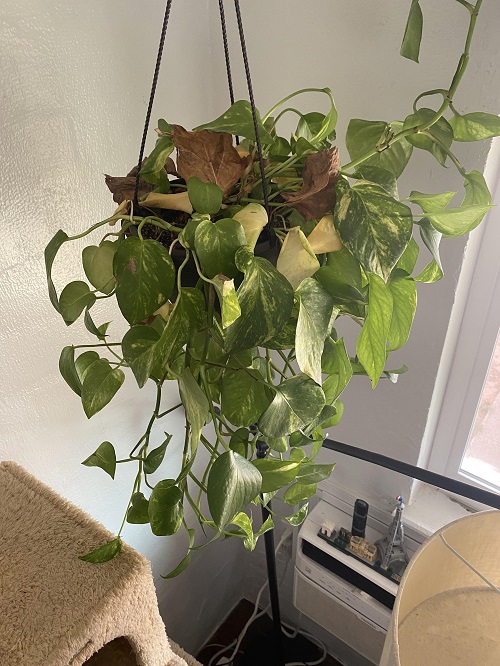
Problem:
Pothos leaves turning brown and crisp are indicative of underwatering.
Solution:
- Increase your watering schedule but make sure not to overwater.
- Keep the soil slightly damp to the touch.
3. Nutrient Deficiency
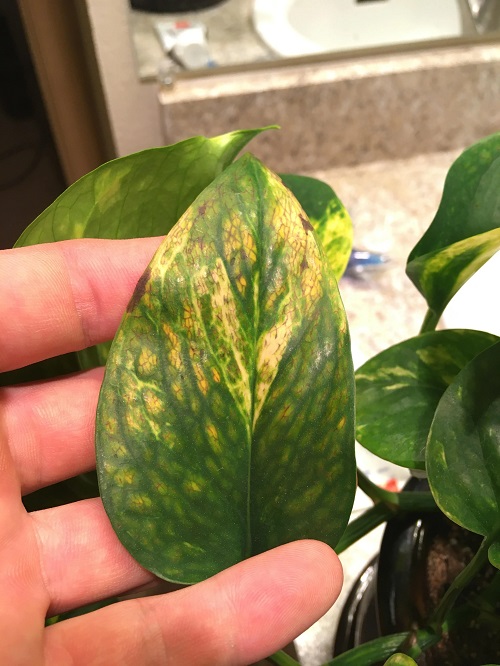
Problem:
Yellowing leaves or stunted growth may signal a lack of essential nutrients.
Solution:
- Use a balanced, water-soluble fertilizer once a month.
- Make sure to follow the instructions on the fertilizer package to avoid over-fertilization.
Pro Tip: For optimal growth, fertilize with a balanced, water-soluble fertilizer diluted to 1/2-1/4 of the recommended strength. Apply once every 4 to 6 weeks, avoiding the winter months when the plant’s growth slows down. Always water your pothos before fertilizing to prevent root burn.
4. Pests

Problem:
Common pests include spider mites and scale insects, which can suck the plant’s vital juices.
Solution:
- Wipe the leaves with a damp cloth to remove the pests.
- Use insecticidal soap or neem oil as a preventative measure.
5. Inadequate Light
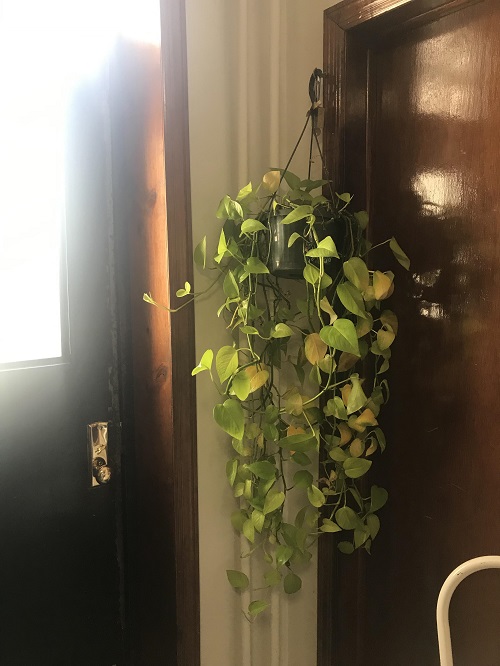
Problem:
Leggy growth and fewer leaves suggest that the plant isn’t getting enough light.
Solution:
- Move the plant to a well-lit area, but avoid direct sunlight.
- Artificial lights can also be used to supplement natural light.
Pro Tip: Direct sunlight can scorch the leaves, while too little light may cause leggy growth and reduced variegation. If you’re growing pothos indoors, a north or east-facing window is ideal.
Less Reported But Common Issues to Watch Out For
6. Cold Stress
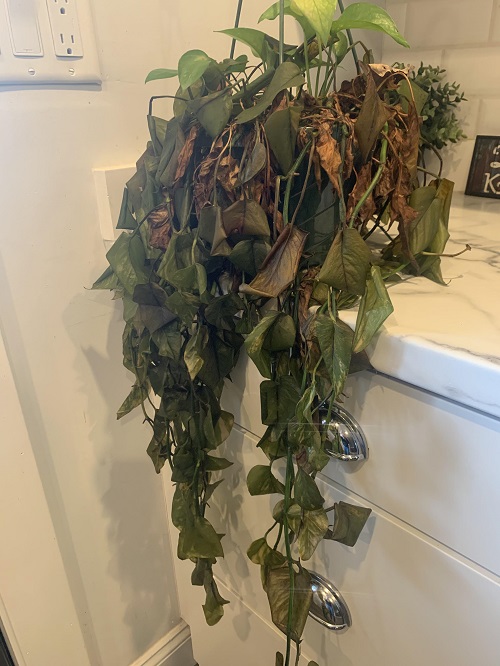
Problem:
If your Pothos is exposed to temperatures below 50°F (10 C), you may notice drooping or yellow leaves.
Solution:
- Move your plant to a warmer location immediately.
- Avoid placing your Pothos near drafty windows or doors in winter.
Note: In general, pothos can tolerate temperatures as low as 50°F (10°C) without significant damage. However, it is important to note that prolonged exposure to temperatures below 60°F (15°C) can negatively affect the plant’s growth and vitality.
7. Salt Build Up
Problem:
Accumulation of salts in the soil, due to excessive fertlization, can lead to leaf burn and overall stress.
Solution:
- Flush the soil with fresh water to remove excess salts.
- Consider repotting the plant in fresh growing medium.
Pro Tip: You’ll typically notice a white, crusty layer on the soil’s surface or around the pot’s rim. Simply water the plant generously, allowing excess water to drain out, removing salts along with it.
8. Bacterial Leaf Spot

Problem:
Dark spots with yellow halos appear on the leaves, often due to high humidity and poor air circulation.
Solution:
- Remove the affected leaves and treat with a copper-based bactericide.
- Improve air circulation around the plant by placing it near a window or door where it gets fresh air without the risk of getting exposed to harsh sunlight for long hours.
Pro Tip: Avoid splashing water on the foliage, as moisture encourages bacterial growth. Opt for watering at the soil level instead. Improve air circulation around the plant to speed up drying and reduce humidity.
Other Issues Worth Noting
9. Temperature and Humidity
- Symptoms: Brown leaf tips, wilting.
- Solution: Maintain a temperature between 60-90°F (15-30°C). Mist the plant if air is too dry.
Note: The plant can tolerate lower and higher temperatures efficiently, but it would be better to avoid exposing it to extreme temperature fluctuations and drafts, as sudden temperature changes can stress pothos.
10. Poor Drainage
- Symptoms: Waterlogged soil, root rot.
- Solution: Ensure the pot has drainage holes. Use a well-draining potting mix.
Pro Tip: A blend of regular indoor potting mix and perlite or coarse sand or orchid bark – works well. This helps prevent waterlogging and promotes healthy root growth.
11. Repotting Stress
- Symptoms: Wilting, drooping leaves post-repotting.
- Solution: Be gentle while repotting and give the plant time to adjust to its new environment by gradually accumulating it to its new location.
Pro Tip: Choose a pot that’s just 1-2 inches larger in diameter than the current one to give your plant room to grow without overwhelming it. When transferring, be gentle with the root ball to minimize stress and damage. Water lightly after repotting to help the plant settle into its new home, but avoid drenching the soil.

